Joseph Haston - 2nd Son of Daniel
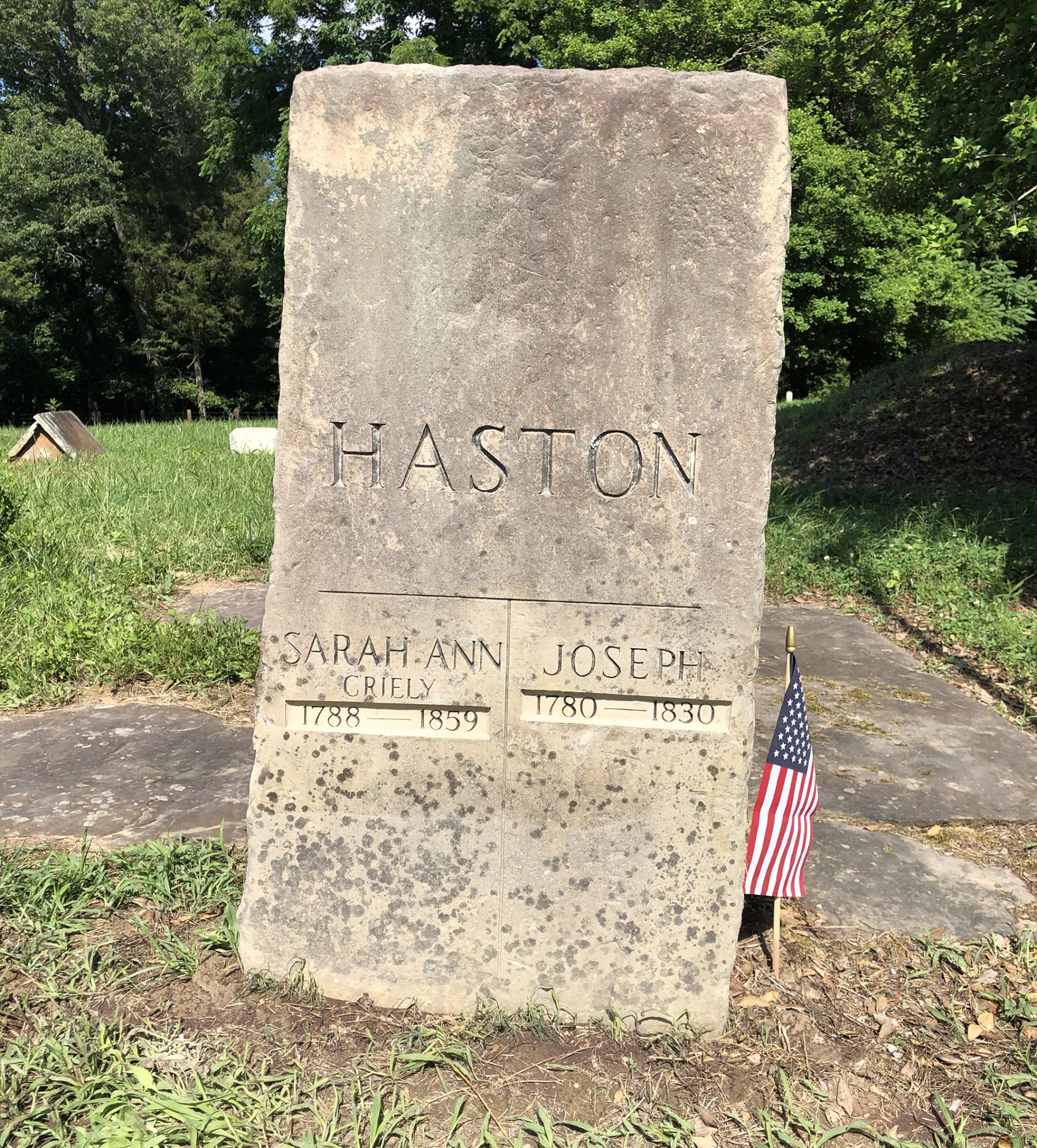
Joseph and David were probably the only two sons of Daniel who were born in Virginia. If we correctly understand the time of Daniel’s departure from Virginia, Joseph would have been three and a half years old when the family moved south. So it’s likely that he had some memories of the journey, and possibly some faint memories of life back in Shenandoah County.
Like David, most of Joseph’s “growing up years” happened in East Tennessee. As the oldest sons, the two of them would have learned early how to hunt and fish to keep the family fed. They would have had to work hard to cut down trees, construct cabins, chop wood for the fireplace, clear ground and till soil for crops, and even be prepared to protect the family from Indian attacks.
All of these early life experiences will forever remain lost to us. But as young adults in Knox County, the men they would become began to emerge. While some of the earlier events in Joseph’s timeline have been covered in previous chapters, here’s an overview of just about everything that I have learned about his life.
Unfortunately, there is less source documentation for Joseph than for Daniel and most of his other sons. Consequently, often I have been forced to rely on “unknown source” information passed down through the family, That information may be properly documented somewhere, but the sources are unknown to me in many cases.
Some Events in the Life of Joseph Haston and His Family
January 9, 1780 – Joseph Haston was born in the midst of the Revolutionary War era. His father, Daniel, was living in Powell’s Fort Valley on the Massanutten Mountain in Shenandoah County, Virginia at the time, so we assume that is where Joseph was born.
The source for Joseph’s birth date is a copy of a family Bible record. Dave R. Haston of Sparta, Tennessee sent the following information to Howard H. Hasting of San Antonio, Texas in a September 4, 1978 letter: “According to a family bible in the possession of Joe Walker of Tennessee Joseph Haston, who was born Jan. 9, 1780, married Sarah Ann Creely, who was born Nov. 7, 1785, and they had a son named James Alford Haston who was born Nov. 25, 1809.”
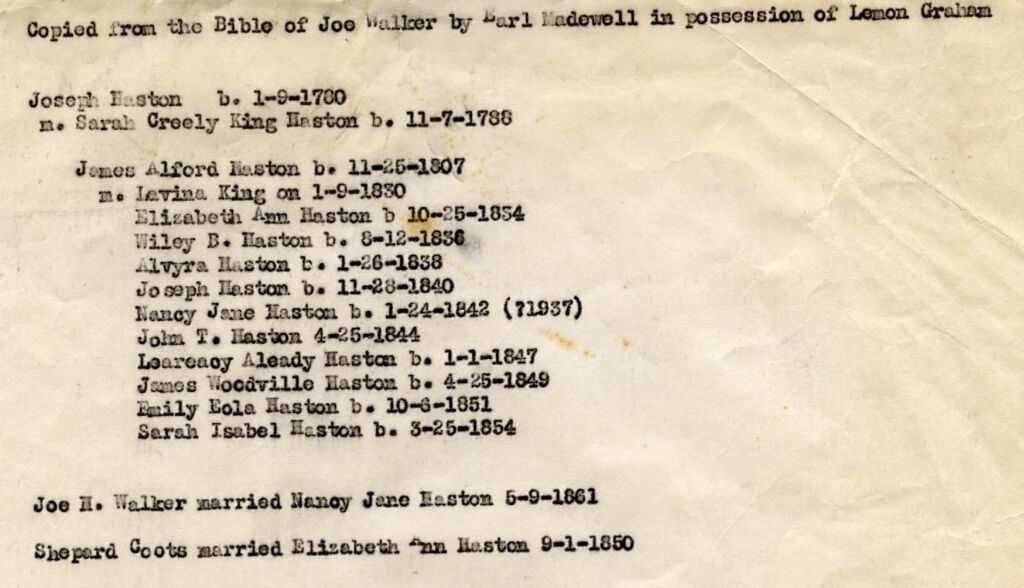
There’s not room here to tell you about all of Joseph and Sarah’s children. Post a question in the Heritage of Daniel Haston Facebook group or contact me through this site and I’ll tell you what I know about any of their children or put you in touch with someone who knows more about the family.
April 1798 – David (not quite age 21) and Joseph (age 18) were tried for cutting the tails off of two horned cows belonging to Nathaniel Hays, whose fence was apparently insufficient to contain the cows. David Hasting, Daniel Hasting, and John Miller put up a total of $100 in bond money for David and Joseph.
January 1800 – A legal dispute between Samuel Cowan and Joseph Hastings appears to have started at this time. It was settled on April 15, 1801.[i] Daniel, apparently, had leased land from John and Jane Woods, through their agent, James Charles. Joseph Haston broke down a fence which allowed Daniel’s swine to trample down a field (“timothy [hay] lot”). Samuel Cowan took Joseph to court, claiming that it was his field that was trampled, and he sued for $1000. Joseph said that he was just doing what Daniel told him to do. This case clearly indicates that Daniel’s home was on leased land and that Joseph was living with his father. The location of the field was “south of the Holston, opposite Knoxville.”
[i] Samuel Cowan vs. Joseph Hastings, Knox County, Tennessee Court of Pleas & Quarter Sessions, Volume 3, 1800-1802, # 1235, 1385, original page 100.

William Charter, James Cunningham, and Sheriff Robert Houston were called upon to witness on behalf of Joseph. George Richards was a witness for Samuel Cowan. Daniel Heastings, Joseph Haston, and David Haston put up the bond of $2000. Joseph and David signed in their own handwriting. Daniel signed with a mark (“x”). Joseph was found not guilty.[i]
[i] Samuel Cowan vs. Joseph Hastings.
November 19, 1802 – Joseph Haston appeared in Guilford County, North Carolina shortly prior to this date. He produced, to the Guilford County Court, a power of attorney document giving him authority to carry out some action for his father (“Dannel Hastons”) in the estate settlement of James Roddey, of “Nox [sic] County” in Tennessee.[i] Chapter 29 contains more background to this James Roddey estate settlement.
[i] Guilford County, North Carolina County Court Minutes, Volume III (November 15, 1802), 227. Microfilm: P. Neg. C.046.30001
About 1806 – The exact date or location of Joseph Haston’s marriage to Sarah Ann Criely/Creely is unknown, but it was probably in or around 1806. According to a page from Dave Rhea Haston’s files, “Sarah Creely King* Haston” was born November 7, 1788.**
July 22, 1806 – The name “Joseph Haston” appeared six signatures above his father, “Dannel Hasstont,” on this petition to form a new country from Jackson County, Tennessee.[i] Joseph’s name was number seventy-nine on the petition, just below his brother-in-law Jacob Mitchell who follows their friend, Isham Bradley.
[i] Legislative Petition # 5-1-1806, “Petition for the Formation of White County from Jackson County, Tennessee.” (Nashville, TN: Tennessee State Library and Archives).
November 25, 1807 – Joseph and Sarah’s first son, James Alford* Haston, was born at this time.[i] *Although records often spell his middle name “Alfred,” it is spelled “Alford” on the Joe Walker Bible record and John Taylor Haston, son of James A. Haston spelled it “Alford” on his 1922 Civil War Questionnaire
[i] Joe Walker family Bible record, in possession of Lemon Graham, copied by Earl Madewell.

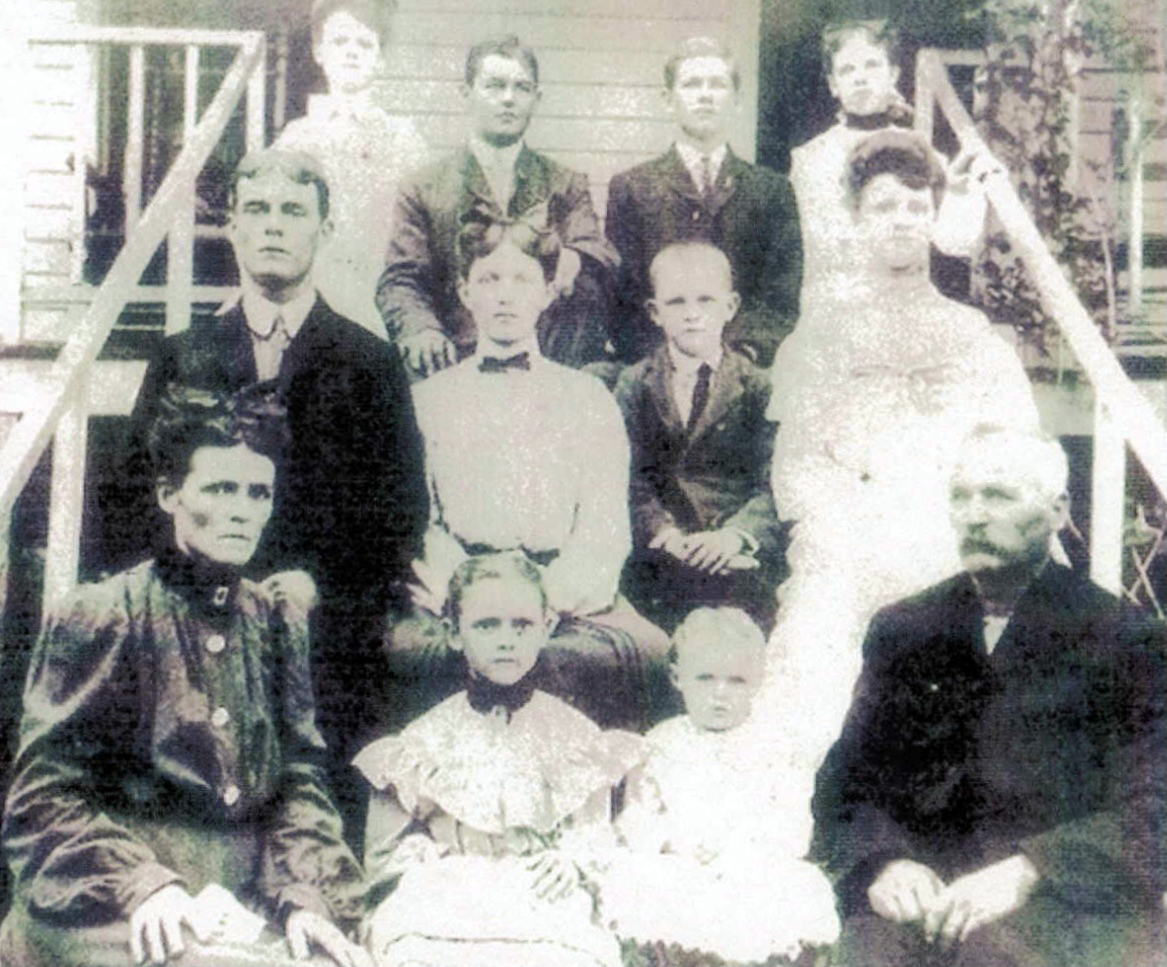
September 20, 1808 – Joseph purchased 50 acres of land in the Third District on the Big Spring Branch, adjacent to Isham Bradley’s 50 acres, as per grant # 550. Like the grants issued to Daniel, Isham Bradley, and Jacob Mitchell, Joseph’s grant was purchased from Thomas Dillon as a part of Dillon’s certificate No. 63. As far as we know, this was the first land Joseph owned, but he wouldn’t own it long.
February 15, 1809 – On the same day that brothers Joseph and David Haston witnessed the Isham Bradley to Charles Mitchell transaction (above) they made a land deal between themselves. For the price of $200, Joseph Hastin sold to David Hastin the 50 acres of land (Grant # 550) that Joseph purchased a few months earlier. The land was adjacent to that of Isham Bradley and Jacob Mitchell. Isham Bradley, Charles Mitchell, and John Miller witnessed the transaction.[i]
Joseph only held this property for about five months.
[i] White County, Tennessee Deed Book B, 1809-1810, 107-109.
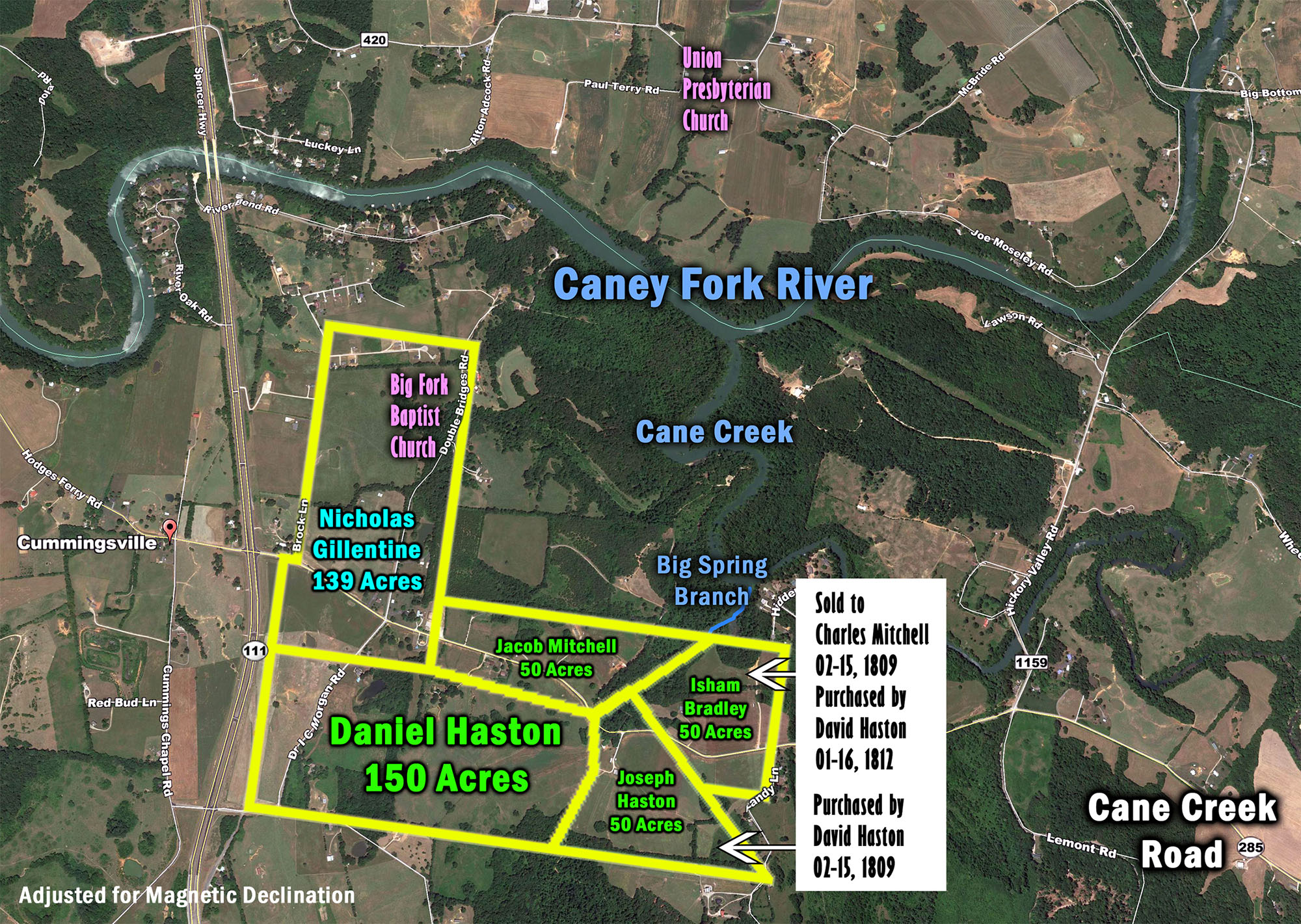
1823 – Daniel Hastin, David Hastin, Joseph Hastin, and Isaac Hastin appeared on this “taxable property and polls” list in Captain Parker’s Company. The listing was taken by D. Hasting, Esq. Daniel’s name reappears on this tax roll, but only has 50 acres situated on Cane Creek, as compared to the 150 acres he owned since 1808. Joseph’s total tax was 1.61 3/4. Now Joseph has 70 acres (listed as being on Cane Creek), instead of 20 acres. He was charged tax for one white poll.[i]
[i] White County, Tennessee Property and Poll Tax, 1821-1825, 101. (original books)
The 50 acres added to Joseph’s land was his inheritance from his father, Daniel. It was located between the acreage that David and Isaac received from Daniel.
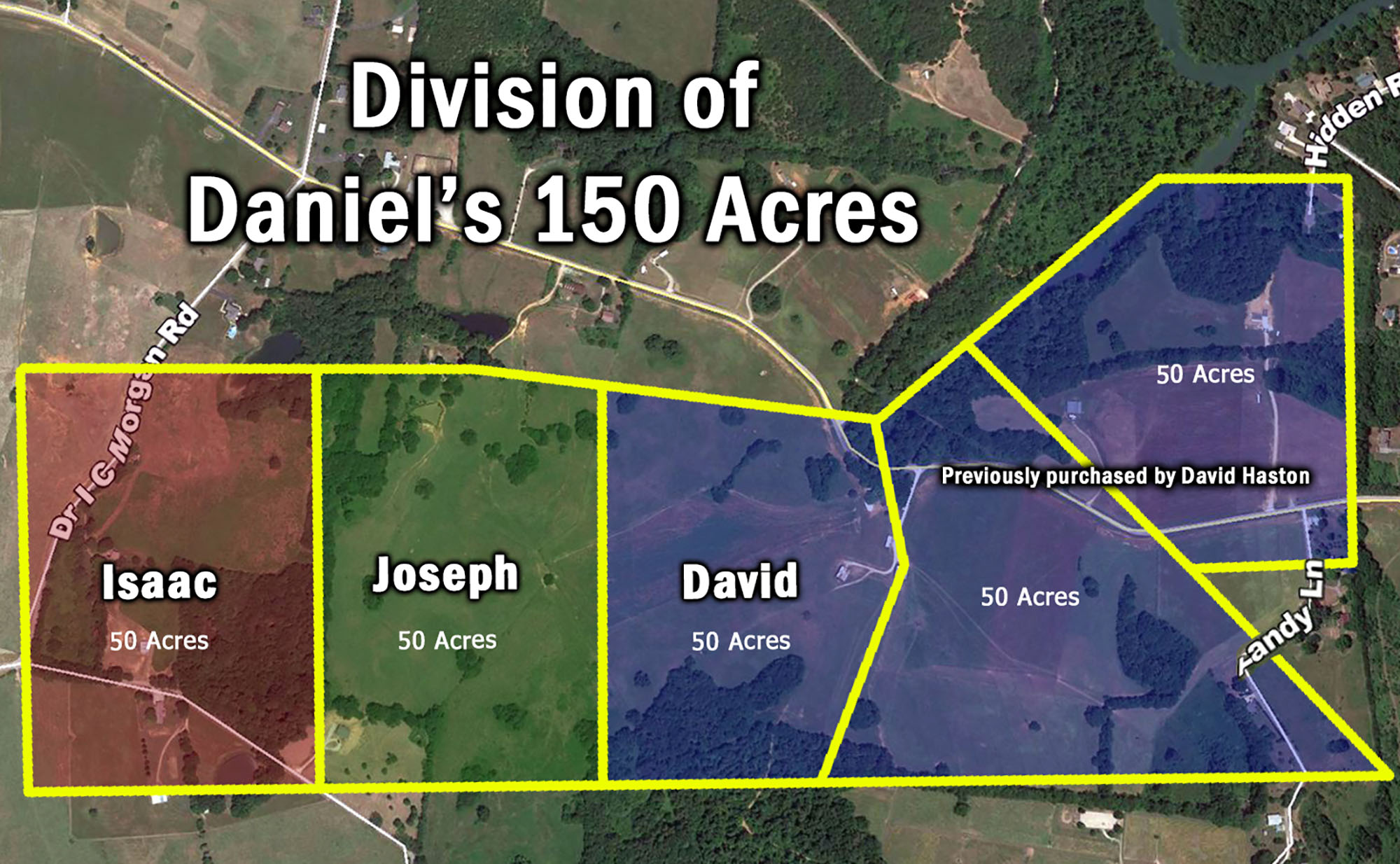
July 19, 1824 – Joseph Hasting was “this day appointed a constable for the full space and term of two years from the date hereof, and thereupon took the oath to support the constitution of the United States, the State of Tennessee and the oath of office, together with the several oaths prescribed by law, and together with David Hasting and Arthur Parker entered into and acknowledge bond in the sum of two hundred and fifty pounds, conditioned as the law requires.”[i] This appointment was made just about five years prior to Joseph’s death. One would think that Joseph must have appeared to be in good health at this time, in order to be appointed as constable.
[i] White County, Tennessee Court Minutes, 1824-1827, Part 1, 43.
The Role of Constables
Based on English law and practice, constables were an important part of law enforcement in early America. They were, in essence, the “arm of the law” in local communities. Constables were elected for a term of two years.
County courts in Tennessee nominated and appointed one constable for each militia district. A constable was required to be a person of “good character” and to swear an oath that he would, among other things, “arrest all such persons” who rode or went “armed offensively” or that “commit or make any riot, affray, or other breach of the peace,” and “apprehend all felons and rioters or persons riotously assembled.” “If any such offenders shall make resistance with force,” they were ordered to execute and return all lawful precepts” as directed to them “without delay.”
Two constables were required to attend each session of a county or circuit court and were paid $1.00 per day for doing so. They were entitled to receive four per cent commission on all money they collected.[i]
[i] John Haywood, Robert L. Cobbs, James A. Whiteside, Jacob P. Chase, The Statute Laws of the State of Tennessee of a Public and General Nature, Volume 1. (Knoxville, TN: General Assembly of Tennessee, 1831), 47-50.
July 23, 1827 – In his will created on this date, Joseph bequeathed all of his property to Sarah, “for the use of the family and the raising of my small children.” The will was witnessed by William Denny, John S. Parker, and Isham Bradley.[i]
[i] White County, Tennessee Inventories and Wills, 92; White County, Tennessee Inventories and Old Wills, 1831-1840, 152.
Joseph Haston's Will
In the name of God, Amen, I Joseph Haston, of the County of White and State of Tennessee, being weak of body but of sound mind and disposing memory for which I thank God and calling to mind the uncertainty of human life, and being desirous to dispose of all such worldly substance as it has pleased God to bless me with after resigning my soul to God and my body to be buried. I do give and bequeath to my beloved wife, Sarah, all my worldly substance with real and personal, to make use of as she thinks proper for the use of the family and the raising of my small children. So long as she may remain a widow and if she should marry my will and desire is that after my wife taking one third part of all my estate the balance to be equally divided amongst my children to be enjoyed by them and their heirs forever, hereby revoking all other wills, testaments by me herefore made. I witness of I have here unto set my hand and seal this 23rd July 1827. Joseph Haston (seal) Signed, sealed, published and delivered to be my last will and Testament in the present of William Denny, John S. Parker, Isham Bradley State of Tennessee, White Co. |
Before 1830 – Apparently, Joseph Haston died shortly prior to the 1830 Federal Census. He is buried in the Big Fork Cemetery very close to where he lived.
November 1859 – Sarah Haston died of croup in November 1859. As could be expected given her age, she had no occupation, profession, or trade. She was ill two days before dying, according to the record.
Yell County, Arkansas

Yell County, Arkansas became a popular settling spot for several of Daniel Haston’s descendants. According to Colonel Howard H. Hasting, a branch of the Haston family (mainly Joseph’s family, but not exclusively) moved to Yell County, Arkansas late in 1879.[i] They mainly settled in the northeast section of Yell County, in and between Danville and Dardanelle, Magazine Township especially.
[i] Hasting, “The Daniel Haston Family,” 32.
Malinda Haston Howard and her family also lived in Magazine Township of Yell County. Her husband William died in 1859 (probably in Tennessee), but Malinda (daughter of Joseph and Sarah Haston) moved to Yell County, Arkansas, and lived there for the remainder of her life.[i]
[i] “Joseph H. Howard,” Biographical and Historical Memoirs of Yell County, Arkansas,” (n.p.: The Southern Publishing Company, 1891). 157.
Joseph and Sarah's Family and the Civil War
William Leonard Dale, Joseph and Sarah's Son-in-Law
Amanda Haston, born in 1831, may have been born shortly after the death of her father. She married William Leonard Dale on March 14, 1858, in White County, Tennessee. William L. Dale was a private in the Confederate Company E of Major Stephen H. Colm’s 1st Tennessee Infantry Battalion.[i] Company E was comprised of many men from White County, under Captain William M. Simpson.[ii] He enlisted in the Confederate Army on January 4, 1863.
[i] National Park Service. U.S., Civil War Soldiers, 1861-1865 [database on-line]. Provo, UT, USA: Ancestry.com Operations Inc, 2007.
[ii] FamilySearch, “1st ( Colm’s ) Tennessee Infantry Battalion,” accessed July 31, 2021, https://www.familysearch.org/wiki/en/1st_Battalion,_Tennessee_Infantry_(Colms%27)_(20th_Battalion)_(Confederate).
[iii] Fold3, “William L. Dale,” accessed July 31, 2021, https://www.fold3.com/image/68088210; 68088215.

The Federal Army’s siege of Port Hudson (March 21, 1863 – July 9, 1863), a Confederate stronghold on the Mississippi River, was the longest siege in American military history, 48 days. During the Union Siege of Port Hudson, Confederate soldiers were reduced to eating nearly anything they could get their hands on, including horses, mules, dogs, cats, and even rats. William joined the Federal Army after being taken a prisoner in Port Hudson, Louisiana and was reported by the Confederates to be a deserter on January 21, 1864.[iii]

This leaves me wondering if the bushwhackers were Federal sympathizers who hanged William Leonard Dale because he was trying to desert the Union Army he had joined under pressure or Confederate sympathizers who hanged him because he had joined the Union Army. Either option is possible, since most of his southern Hickory Valley neighbors were passionately pro-Confederacy with several local “sons” in the army, but in 1864 Federal troops were roaming all over White and surrounding counties.
Wiley B. Haston (son of Joseph & Sarah)
Wiley B. Haston, son of James Alford and Lavina King Haston, was mortally wounded in the Battle of Perryville, Kentucky on October 8, 1862 and died the following day.

Willie B. Haston enlisted as a private in the Confederate Company I of the Sixteenth Tennessee Voluntary Infantry Regiment on May 20, 1861 at Camp Harris in Estill Springs of Franklin County, Tennessee. This regiment was made up of volunteers from Warren, Van Buren, White, and surrounding Middle Tennessee Counties.
Approximately 36,000 soldiers fought in the battle—20,000 Union and 16,000 Confederate, with 7,621 total casualties (killed or wounded) in one afternoon. The Sixteenth Tennessee suffered 219 casualties out of 370 engaged—59.2 % (most of any regiment). Willie B. Haston’s company, along with other companies in the Sixteenth, was ordered to charge uphill into the face of two batteries of cannons (one on their right, another on their left) that were firing canister shots (closed tin cylinder typically loosely filled with round lead or iron balls) into their ranks. As it turned out there was also a Wisconsin line of Federals behind a fence between the two batteries.
The Sixteenth Tennessee Regiment fought valiantly in its first major battle and the Confederates eventually captured the knobs defended by the Union Army. But because there were 35,000 Federal troops being held in reserve, General Braxton Bragg ordered his much smaller army to retreat to Tennessee.
Wiley B. Haston’s body was not interred at the battle field as were many others, but was claimed by the family. According to a story passed down through the family, “Burdin Wheeler and John T. Haston [Wiley B.’s brother] brought the body home to Spencer” and it was buried in an unmarked grave beside James A. [his father] in the town cemetery.”[i]
[i] Dwight Haston, email to Dave R. Haston, December 8, 1973.
John Taylor Haston - Prisoner of War
The cavalry took up the rear, and I yet remember seeing John T. Haston in line, and he gave me some rations. John is yet living, and has his wings up, has never sold out for a mess of pottage and never will. If I go to war again, I want John with me.
-Carroll H. Clark’s Diary

John Taylor Haston (April 25, 1844 – January 2, 1923) enlisted in Colonel Murray’s Fourth Tennessee Confederate Cavalry at Chattanooga, Tennessee on June 14, 1862. Six of his Haston relatives joined this unit on the same date—James Hastin, James M. Hastin, John L. Hastin, Miles H. Hastin, Richmond Hastin, William Hastin, and William S. Hastion.[i] They were all in Captain George W. Carter’s Company A.
[i] John C. Rigdon, Historical Sketch and Roster of the Tennessee 4th Cavalry Regiment (Murray’s). (Cartersville, GA: Eastern Digital Resources, 205), 39.
Like his brother’s (Wiley B. Haston’s) regiment, the Fourth Tennessee Cavalry marched to Kentucky and fought in the Battle of Perryville just 117 days later. John Taylor’s cavalry’s unit fared much better than his brother’s infantry, with only one killed and two wounded.[i]
[i] Rigdon, 17.
On 16 September 16, 1863, while attempting to visit his family, he was captured at Sparta, Tennessee, and sent to the military prison at Louisville, Kentucky. In October 1863, he was transferred to Camp Morton in Indianapolis, Indiana.* Camp Morton has been called a “Den of Misery,” one of the most inhuman northern Civil War prison camps operated by the Union Army.[i]
[i] James R. Hall, Den of Misery: Indiana’s Civil War Prison. (Gretna, LA: Pelican Publishing Company, 2006).
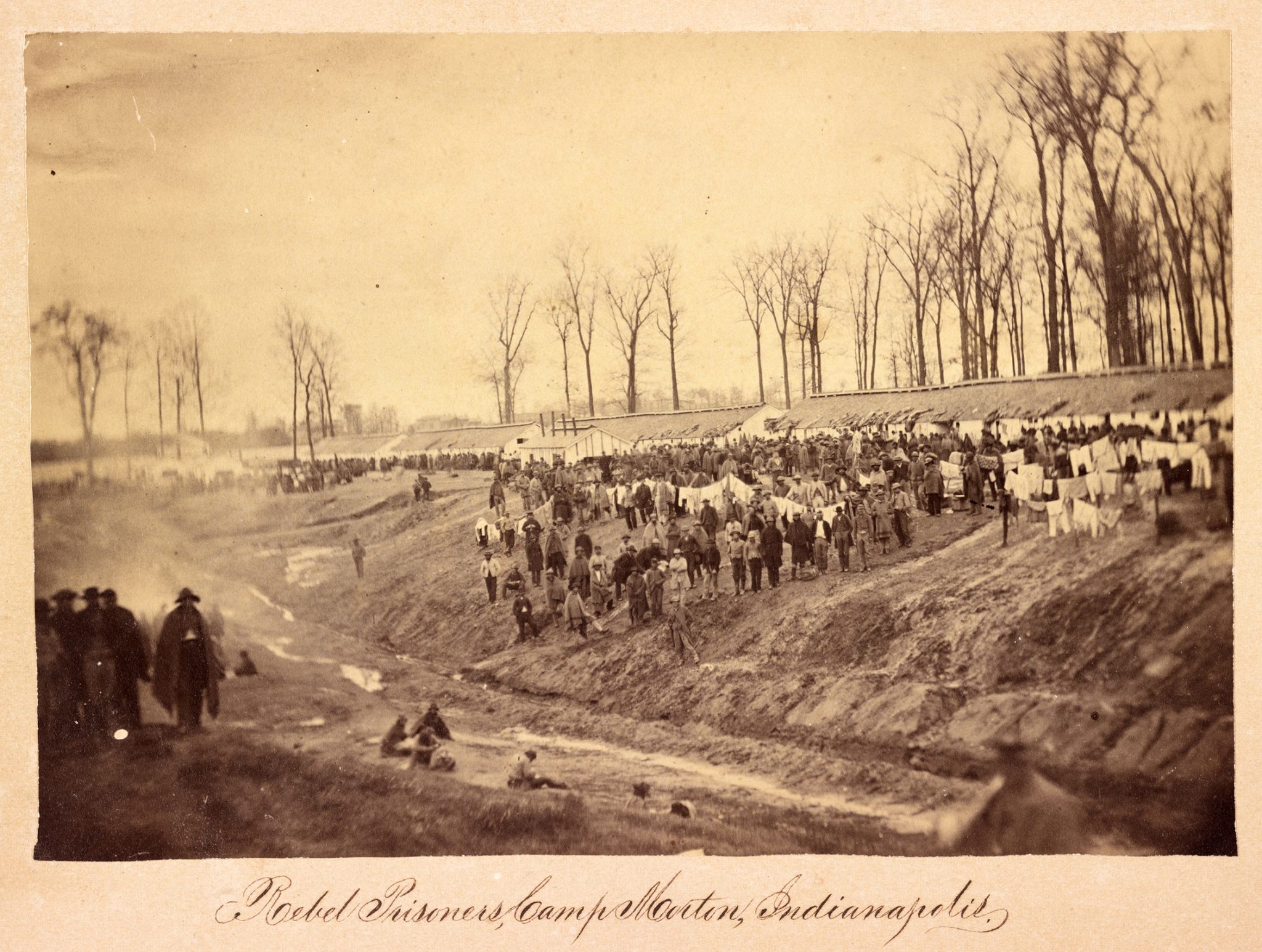
He was paroled and released on May 22, 1865, which was late in the process of emptying the camp. His prison record shows that he was of dark complexion, with dark hair and eyes and 5 ft. 5 1/2 ins. tall.
If you appreciated this article, please share it with others who might also enjoy it.

